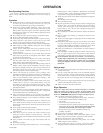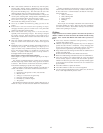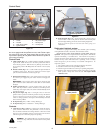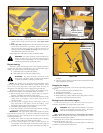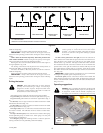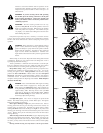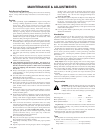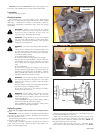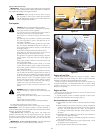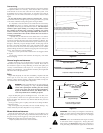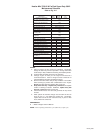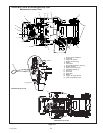
MAINTENANCE & ADJUSTMENTS
Safe Servicing Practices
This product is capable of amputating hands and feet and throwing
objects. Always follow all safety instructions to avoid serious injury or
death.
Service
▲
Unless specifically required, DO NOT have engine running when
servicing or making adjustments to tractor. Park the machine on
level ground. Place steering control levers in the park brake
position, disengage deck clutch, lower deck, remove ignition switch
key and disconnect negative battery cable before doing any
maintenance. Wait for all movement to stop before adjusting,
cleaning or repairing. Repairs or maintenance requiring engine
power should be performed by trained maintenance personnel only.
To prevent carbon monoxide poisoning, be sure proper ventilation is
available when engine must be operated in an enclosed area. Read
and observe safety warnings in front of manual.
▲
Before working on or under the deck, make certain engine cannot be
accidentally started. Shut engine off and remove ignition switch key
for maximum safety. Repairs or maintenance requiring engine
power should be performed by trained maintenance personnel only.
▲
Except when changing or checking belt, always keep belt covers on
mower deck for safety as well as cleanliness.
▲
Use a stick or similar instrument to clean under the mower making
sure that no part of the body, especially arms and hands are under
mower.
▲
Keep your machine clean and remove any deposits of trash and
clippings, which can cause engine fires and hydraulic overheating as
well as excessive belt wear. Clean up oil or fuel spillage. Allow
machine to cool before storing.
▲▲
Clean flammable material from machine. Prevent fires by
keeping engine compartment, top of deck, battery, exhaust area,
fuel line, fuel tank and operator’s station clean of accumulated
trash, grass clippings, and other debris. Always clean up spilled
fuel and oil.
▲
Always wear adequate eye protection when servicing the hydraulic
system and battery, or when grinding mower blades and removing
accumulated debris.
▲
Use extra caution when handling gasoline and other fuels. They are
flammable and vapors are explosive.
▲
Never attempt to start engine when there is a strong odor of gasoline
fumes present. Locate and correct cause.
▲
Never remove the fuel cap or refuel tractor while engine is running;
never refuel near an open flame or near devices which can create a
spark. Refuel outdoors. Never refuel or drain the fuel from the
machine indoors.
▲
Never run the engine in an enclosed area unless exhaust is vented to
the outside. Exhaust gases contain carbon monoxide which is
odorless and deadly poison.
▲
Never attempt to make any adjustments or repairs to the tractor drive
system, mower deck or any attachment while the tractor engine is
running or deck clutch is engaged. Repairs or maintenance requiring
engine power should be performed by trained maintenance personnel
only.
▲
Never work under the machine or attachment unless it is safely
supported with jack stands. Make certain machine is secure when it
is raised and placed on the jack stands. The jack stands should not
allow the machine to move when the engine is running and the drive
wheels are rotating. Use only certified jack stands. Use only
appropriate jack stands, with a minimum weight rating of 2000
pounds to block the unit up. Use in pairs only. Follow the
instructions supplied with the vehicle stands.
▲
Do not touch hot parts of machine.
▲
Keep nuts and bolts tight, especially the blade attachment bolts.
Keep equipment in good working condition.
▲
Never tamper with safety devices. Check their proper operation
regularly.
▲
Stop the engine before removing the grass catcher or unclogging the
discharge chute. Never clear the discharge chute with the engine
running. Turn off the engine and be sure the blades have stopped
before cleaning. Use a stick to clear a plugged discharge area.
Never use your hand!
▲
Grass collection system components are subject to wear, damage and
deterioration, which could expose moving parts or allow objects to
be thrown. Frequently check components and replace with
manufacturer’s recommended parts, when necessary.
▲
Exercise caution when working under the deck as the mower blades
are extremely sharp. Wrap the blade(s) or wear gloves and use extra
caution when servicing them.
▲
Use only genuine Hustler replacement parts to ensure that original
standards are maintained
Introduction
Regular maintenance is the best prevention for costly downtime or
expensive, premature repair. The following pages contain suggested
maintenance information and schedules which the operator should follow
on a routine basis. The following pages contain suggested maintenance
information and schedules which the operator should follow on a routine
basis. For more detailed information order the correct parts manual for
your unit. Refer to the Product Literature section of this manual.
Remain alert for unusual noises, they could be signaling a problem.
Visually inspect the machine for any abnormal wear or damage. A good
time to detect potential problems is while performing scheduled
maintenance service. Correcting the problem as quickly as possible is the
best insurance.
Clear away heavy build-up of grease, oil and dirt, especially in the
engine and under the seat platform areas; minute dust particle are abrasive
to close-tolerance engine and hydraulic assemblies.
Daily inspect mower for grass clippings and wire and string tangles.
The underside of the mower deck will collect a build-up of grass clippings
and dirt, especially when grass is wet or has high moisture content. This
build-up will harden, restricting blade and air movement and will probably
show a poorer quality of cutting. Therefore it should be removed routinely.
To do this it will be necessary to raise and block the deck, using jack
stands or blocks, in the full up position and scrape the build-up from
underneath.
Some repairs require the assistance of a trained service mechanic and
should not be attempted by unskilled personnel. Consult your Hustler
service center when assistance is needed.
Torque values
WARNING: Particular attention must be given to tightening
the drive wheel lug nuts and blade spindle bolts. Failure to
correctly torque these items may result in the loss of a wheel
or blade, which can cause serious damage or personal injury.
Torque values are given below:
Ft-lbs. Nm
Wheel (lug) nuts . . . . . . . . . . . . . . . . . . . . . . .65-75 . . . . . .88.14-101.7
Blade spindle bolt top . . . . . . . . . . . . . . . . . . .118 . . . . . . . . .160.01
Blade spindle bolt bottom . . . . . . . . . . . . . . . .118 . . . . . . . . .160.01
Lug nuts only - It is recommended that these be checked after the first 2
hours of operation, initially, every 50 hours and following removal for
repair or replacement.
For all other torques refer to the various tractor parts manuals for
standard torque chart. See page 21 for ordering information.
For engine torque values, see engine owner’s manual.
Tires
It is important for level mowing that the tires have the same amount of
air pressure. The recommended pressure are:
Drive wheels...............................................8-12 psi (55-83 KPa)
Gauge wheels .............................................8-12 psi (55-83 KPa)
107708_0808
19



